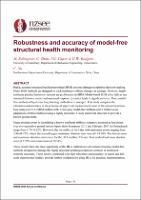| dc.description.abstract | Rapid, accurate structural health monitoring (SHM) assesses damage to optimise decision-making. Many SHM methods are designed to track nonlinear stiffness changes as damage. However, highly nonlinear pinched hysteretic systems are problematic in SHM. Model-based SHM often fails as any mismatch between model and measured response dynamics leads to significant error. Thus, model-free methods of hysteresis loop tracking methods have emerged. This study compares the robustness and accuracy in the presence of significant measurement noise of the proven hysteresis loop analysis (HLA) SHM method with 3 emerging model-free methods and 2 further novel adaptations of these methods using a highly nonlinear, 6-story numerical structure to provide a known ground-truth.
Mean absolute errors in identifying a known nonlinear stiffness trajectory assessed at four points over two successive ground motion inputs from September 2010 and February 2011 in Christchurch range from 1.71-10.52%. However, the variability is far wider with maximum errors ranging from 3.90-49.72%, where the second largest maximum absolute error was still 19.74%. The lowest mean and maximum absolute errors were for the HLA method. The next best method had mean absolute error of 2.92% and a maximum of 10.51%.
These results show the clear superiority of the HLA method over all current emerging model-free methods designed to manage the highly nonlinear pinching responses common in reinforced concrete structures. These results, combined with high robustness and accuracy in scaled and full-scale experimental studies, provide further validation for using HLA for practical implementation. | |

